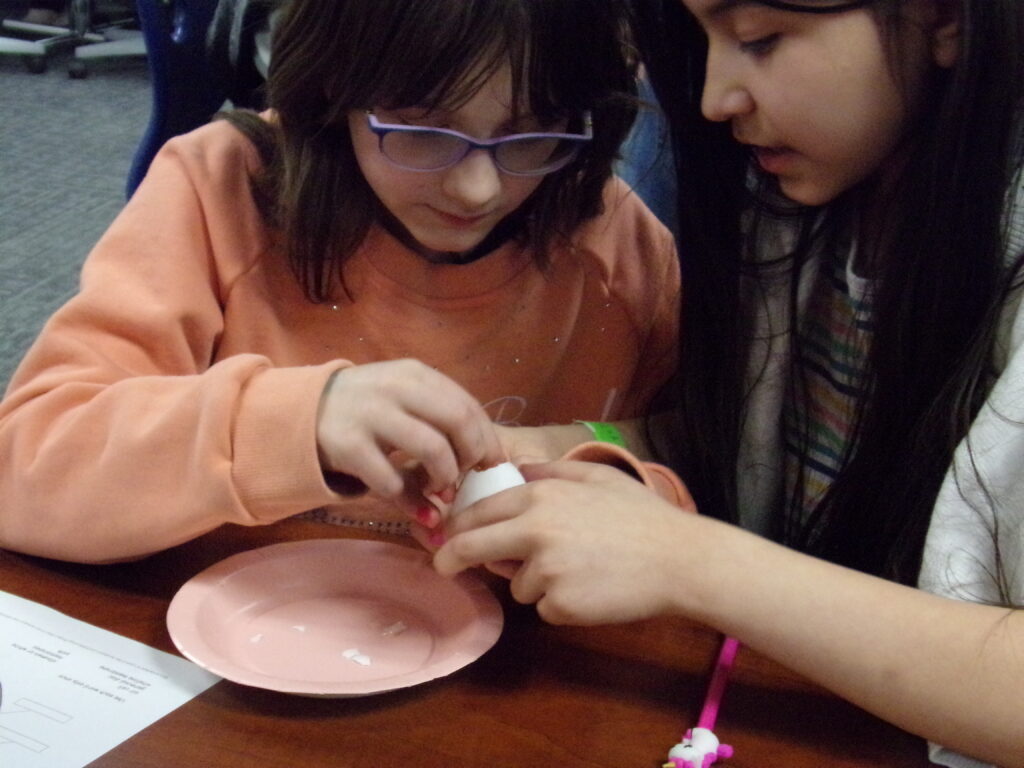By Bella Buckner, Georgia Arneson and Chloe Thomas. Photos by Chloe Thomas and Renae Collins
Karyssa Pembrook sits in the STEAM Lab with her partner and cracks open an egg. The Epic fifth-grader is busy identifying parts of the egg and getting her hands messy.
Pembrook and her lab partner label those parts on a worksheet. Pembrook, who wants to be a sports medicine doctor one day, is getting her first lab experience during STEAM club.
“These guys are going to be our future engineers or future doctors, scientists, NASA,” said Stacey Halsey, an Epic teacher and STEAM club leader.

Halsey has a degree in molecular biology and loves educating future scientists.
To help her do that, Epic is putting resources into science and technology programs by offering ZSpace, STEAM Clubs and new MakerSpace labs.
Halsey said giving students the opportunity to do hands-on work is key to preparing them for the future.
“I think that knowing your STEAM subjects — science, math, any of that — is really something that students need a good foundation of because it helps them be able to make informed decisions in life as they are adults,” Halsey said.
Ben Finkbeiner is the director of STEAM at Epic Charter Schools. Finkbeiner said Epic received a grant about three years ago to create ZSpace labs in rural Oklahoma. Epic then continued funding ZSpace labs, starting in Tulsa and Oklahoma City and then in rural cities across the state. There are now four labs and 40 traveling laptops that teachers take around the state.

ZSpace is an interactive science learning program that uses augmented reality or virtual reality technology. ZSpace is a technology-based class that uses 3D glasses that track head movement. It also comes with a stylus that allows participants to move the images around. Finkbeiner said AR/VR experiences are important to prepare students for future jobs.
“If you are going to be applying for the job in the next five or six years, there’s a good chance that your future employer will be asking you questions like, ‘Have you ever learned using AR/VR? Have you ever trained using technology like ZSpace?’” Finkbeiner said. “For our students to be able to say, yes, they’ve learned that environment, that they enjoy that environment, that they’re comfortable in that environment, I think that it really gives them a leg up.”
ZSpace is now transitioning to MakerSpace Labs/STEAM Labs to offer more science and technology options.
Some of the new options will include things like VR goggles with educational apps, 3D printers, LEGO robotics and other hands-on learning activities.
The labs are going to have what Finkbeiner calls a “menu,” which is a card with the different activities available to the students and teachers.
“A teacher could just go in, grab a menu card, collect all of the supplies, have the students do a scientific experiment, and then have a recap and journal, and be able to leave, all within an hour,” Finkbeiner said.
His goal is to give all Epic students hands-on opportunities.
“Young students have to have the opportunity to fail and then make an adjustment and make it better, or to have something collapse and crumble and break and then fix it and to be able to use their hands doing those things,” Finkbeiner said.
As Pembrook finishes her egg dissection, this messy, hands-on STEAM Club project taught her new skills she hopes she’ll use in a future medical career.
Top Photo Caption: Students in Epic’s Tulsa STEAM Club meet at the Logan Building to learn about the anatomy of an egg. The STEAM Club and ZSpace (also known as MakerSpace) labs give students hands-on and VR learning opportunities.

